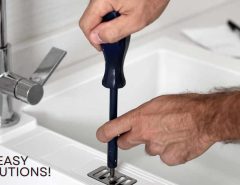Ah, the kitchen – the heart of the home, a place of culinary creation, shared meals, and warm memories. But sometimes, an unwelcome guest arrives, bringing with it an unpleasant stench that seems to waft up from the most unlikely place: the kitchen sink drain. That persistent, foul odor can quickly turn a pleasant cooking experience into something far less appealing.
If you’ve ever found yourself holding your breath while doing the dishes or wondering what exactly is living down there, you’re not alone. Kitchen sink drain odors are incredibly common, but the good news is that they are usually fixable with simple household items and a little know-how.
In this ultimate guide, we’ll dive deep into why your drain smells bad, how to effectively eliminate those nasty odors using various proven methods (from natural remedies to stronger solutions), and most importantly, how to keep your drain smelling fresh in the long run. Say goodbye to holding your nose – let’s tackle that sink smell head-on!
Why Does My Kitchen Sink Drain Smell So Bad? The Root Causes
Before we can banish the odor, it helps to understand where it’s coming from. Most kitchen sink drain smells are caused by the decomposition of organic matter that gets washed down the drain over time. Think of all the food scraps, grease, and other bits that go down daily.
Here are the most common culprits:
-
Food Particle Buildup:
Even with a garbage disposal or a sink strainer, tiny food particles invariably make their way into the drain pipe. These particles cling to the sides of the pipes, especially in the P-trap (the curved section under the sink), and begin to decompose. As they break down, bacteria flourish, producing gases that smell like rotten eggs, sulfur, or just general decay. This is by far the most frequent cause.
-
Grease and Fat Solidification:
Pouring grease, oils, or fats down the drain is a major no-no. While they might go down as a liquid, they cool and solidify inside the pipes, creating a sticky lining. This lining not only traps food particles but also becomes a breeding ground for odor-causing bacteria. Over time, this buildup can restrict flow and worsen smells.
-
Bacterial Growth:
Warm, damp, and nutrient-rich environments are perfect for bacteria. The inside of your drain pipe, particularly the P-trap, is precisely this environment. These bacteria feed on the accumulated gunk and produce foul-smelling gases as a byproduct.
-
A Dry P-Trap:
The P-trap isn’t just for catching dropped rings; it’s a crucial part of your plumbing designed to hold a small amount of water. This water acts as a seal, preventing noxious sewer gases from coming up into your home. If a sink isn’t used for a long time, the water in the P-trap can evaporate, breaking the seal and allowing sewer odors to enter your kitchen. Sewer gas smells distinctively like sewage or very strong rotten eggs (due to hydrogen sulfide).
-
Vent Pipe Issues:
Plumbing systems have vent pipes (usually leading through the roof) that allow fresh air into the system. This helps water drain properly and prevents vacuum effects. If a vent pipe is blocked (by leaves, nests, etc.), it can disrupt the airflow, causing slow drains, gurgling sounds, and sometimes allowing sewer gases to back up and cause odors. This is a less common DIY fix cause, but important to be aware of.
-
Mold and Mildew:
In humid environments, mold and mildew can grow in and around the drain opening, sink overflow (if present), and even inside the top of the drain pipe if there’s standing moisture and organic matter. These can contribute a musty or earthy smell.
Understanding the cause helps you choose the most effective removal method. For most common food and grease buildup smells, simple cleaning methods work wonders.
Prevention is Key: Stop the Smell Before It Starts
While removing existing odors is important, preventing them from forming in the first place is even better. Adopting a few simple habits can save you a lot of hassle down the line:
- Scrape Plates Thoroughly: Before rinsing dishes, scrape all food scraps into the trash or compost bin. Don’t rely solely on the garbage disposal to handle large quantities of food waste.
- Mind the Grease: Never pour cooking grease, oil, or fat down the drain. Allow it to cool and solidify, then scrape it into the trash. For smaller amounts (like greasy pans), wipe out as much as possible with a paper towel before washing.
- Use a Sink Strainer: A simple mesh strainer placed over the drain opening is your best friend. It catches food particles, coffee grounds, tea leaves, and other debris before they can enter the drain pipe. Remember to empty the strainer into the trash regularly!
- Be Careful with “Problem” Foods: Certain foods are notorious for causing drain clogs and smells. These include coffee grounds, eggshells, pasta, rice (which expand), fibrous vegetables (like celery stalks), and starchy items (like potato peels). Try to dispose of these in the trash or compost whenever possible.
- Regularly Flush with Hot Water: Make it a habit to run the hottest water from your tap for a minute or two after doing dishes. This helps to push residual grease and food particles down the drain and prevent them from accumulating.
- Clean the Strainer and Drain Opening: Don’t forget to regularly clean the visible parts of your drain, including the stopper, strainer, and the area immediately around the drain opening. Soap scum, food residue, and grime can build up here and contribute to smells.
Ready to Tackle the Odor? Here Are Proven Methods
Okay, you’ve got a smell right now. Let’s get rid of it! We’ll start with the simplest, most natural methods and move towards potentially stronger options. Always try the easiest methods first.
Method 1: The Boiling Water Flush (Simple & Effective for Minor Buildup)
This is your first line of defense and surprisingly effective for minor grease buildup.
- What you need: A kettle or pot to boil water.
- How to do it:
- Boil a large pot or kettle full of water.
- Carefully pour the boiling water slowly and directly down the drain opening.
- Wait a few minutes and repeat with a second kettle of boiling water if necessary.
- Why it works: The heat from the boiling water helps to melt and loosen grease and flush away some of the accumulated gunk that’s causing the smell.
- Caution: Be careful not to splash the boiling water on yourself. While usually safe for modern metal or PVC pipes, avoid pouring boiling water if you have very old, brittle plastic pipes or if you’ve recently used a chemical drain cleaner (the heat can react with residual chemicals).
Method 2: The Dynamic Duo – Baking Soda and Vinegar (Natural & Powerful)
This is a classic, environmentally friendly method that creates a cleaning reaction right in your drain.
- What you need: Baking soda (sodium bicarbonate), white distilled vinegar (acetic acid), hot tap water.
- How to do it:
- Pour about 1/2 cup to 1 cup of baking soda directly down the drain. Try to get as much of it as possible into the drain opening itself, not just around the sink basin.
- Next, pour about 1 cup of white vinegar down the drain.
- Immediately, you’ll see a fizzing reaction (this is the baking soda and vinegar reacting to produce carbon dioxide gas). This bubbling action helps to loosen grime and debris from the pipe walls.
- Quickly cover the drain opening with the sink stopper or a rag to keep the reaction and gases working inside the pipe.
- Let it sit and work for at least 15-30 minutes, or even longer (up to an hour) for tough odors.
- After the waiting period, uncover the drain and flush it thoroughly with hot tap water for a minute or two to rinse away the loosened gunk and residual baking soda/vinegar mixture.
- Why it works: Baking soda is a natural deodorizer and mild abrasive. Vinegar is an acid that reacts with the baking soda. The resulting chemical reaction (NaHCO3+CH3COOH→CH3COONa+H2O+CO2) causes fizzing that helps to physically dislodge buildup. Vinegar also has disinfectant properties that can help kill some odor-causing bacteria.
- Best for: General organic buildup and grease.
Method 3: Salt and Hot Water (Simple Abrasive Action)
Another easy method using common kitchen items.
- What you need: About 1/2 cup of table salt, hot tap water.
- How to do it:
- Pour the salt down the drain.
- Immediately follow with a good amount of hot tap water (run the hot water for a minute or two).
- Why it works: The salt acts as a mild abrasive, helping to scrub the sides of the pipe as it’s washed down, while the hot water helps to dissolve and flush away grease.
- Best for: Minor, fresh buildup. Can be used in conjunction with or as a follow-up to other methods.
Method 4: Ice and Salt (For Drains with Garbage Disposals)
If you have a garbage disposal, this is a great method to clean and sharpen the blades while also tackling odors.
- What you need: About 2 cups of ice cubes, 1/2 cup of rock salt (or table salt), citrus peels (optional – lemon, lime, orange).
- How to do it:
- Turn on the cold water faucet to a steady stream.
- Turn on the garbage disposal.
- Carefully feed the ice cubes and salt down the drain while the disposal is running. The ice helps to solidify grease, and the salt acts as an abrasive to scour the grinding chamber and blades.
- Optional: After the ice and salt are gone, add a handful of citrus peels. The disposal will grind them up, releasing a fresh scent.
- Turn off the disposal once all the ice/salt/peels have been ground up.
- Let the cold water continue to run for about 30-60 seconds to flush everything away.
- Why it works: The ice hardens any grease, and the ice/salt combination effectively scours the grinding chamber, breaking up and flushing away food particles and grime that cause odors. Citrus peels add a pleasant smell.
- Best for: Odors originating within the garbage disposal unit itself.
Related: How to convert a sink into a shower [DIY Solution]
Method 5: The Plunger (Physical Disruption)
Sometimes, a physical blockage or clump of gunk needs to be dislodged.
- What you need: A clean sink plunger (one specifically for sinks, not toilets, is ideal as it has a flat base).
- How to do it:
- Fill the sink basin with enough hot water to cover the bell of the plunger.
- Make sure the seal around the drain opening is tight. If you have a double sink, you’ll need to seal the other drain opening with a stopper or wet rag to create proper suction.
- Place the plunger firmly over the drain, ensuring a good seal.
- Plunge vigorously up and down for 10-15 strokes.
- Remove the plunger and see if the water drains quickly. Repeat if necessary.
- Flush with hot water.
- Why it works: The plunging action creates pressure and suction that can help to break apart or dislodge clogs and buildup further down the pipe.
- Best for: Odors potentially linked to a partial blockage.
Method 6: Clean the Strainer and Overflow (Often Overlooked)
Sometimes the smell isn’t from the depths of the drain, but from the parts you can see or access easily.
- What you need: Dish soap, an old toothbrush or small brush, hot water, maybe a thin brush for the overflow.
- How to do it:
- Remove the sink strainer or stopper.
- Use dish soap and hot water to thoroughly scrub the strainer, removing any trapped food particles, grease, and grime.
- Clean around the drain opening in the sink basin.
- If your sink has an overflow drain (a small hole usually near the top of the basin), this can also collect grime. Use a small, thin brush (like a bottle brush or even a pipe cleaner) dipped in soapy water to clean inside the overflow channel.
- Rinse thoroughly with hot water.
- Why it works: Prevents debris from entering the drain and removes buildup from accessible, odor-causing areas.
- Best for: Musty smells or smells originating from the immediate drain area.
Method 7: Drain Brush or Snake (Mechanical Removal)
For buildup just beyond easy reach, a drain brush or snake can be helpful.
- What you need: A flexible drain brush designed for pipes or a small drain snake/auger.
- How to do it:
- Carefully insert the drain brush or snake into the drain opening.
- Gently push and twist the brush/snake down the pipe as far as it will go, focusing on the curved P-trap area.
- Maneuver the tool to break up or pull out any debris.
- Slowly withdraw the brush/snake, wiping off any gunk with a paper towel as you go.
- Flush the drain with hot water.
- Why it works: Provides physical action to dislodge or pull out gunk that brushing or flushing alone might miss.
- Best for: Buildup in the upper part of the drain pipe or the P-trap.
Method 8: Enzyme-Based Drain Cleaners (Biological Approach)
These cleaners use beneficial bacteria or enzymes to digest organic matter. They are much gentler on pipes and the environment than chemical cleaners.
- What you need: An enzyme-based drain cleaner (available at hardware stores, supermarkets, or online). Follow product instructions carefully.
- How to do it: Follow the specific instructions on the product packaging. Typically, you pour a specified amount down the drain, often before bed, and let it work overnight. Avoid using the sink while the cleaner is active.
- Why it works: The enzymes or bacteria in the cleaner break down organic substances (food, grease, hair) into water-soluble components that can be easily flushed away. They target the cause of the odor by consuming the source material.
- Best for: Stubborn organic buildup and recurring odors. Safer for regular maintenance.
Method 9: When to Consider Chemical Drain Cleaners (Use with Extreme Caution)
Chemical drain cleaners are a last resort for kitchen sink odors due to their harsh nature. They can damage certain types of pipes (especially older or PVC pipes if misused), are toxic, and environmentally unfriendly.
- What you need: A chemical drain cleaner formulated for grease (check the label carefully).
- How to do it: Follow the product instructions precisely. Wear gloves and eye protection, ensure excellent ventilation, and never mix different chemical cleaners (this can create dangerous fumes). Do not use a plunger after using a chemical cleaner.
- Why it works: These cleaners typically use strong alkaline (like lye) or acidic chemicals that dissolve or break down organic matter chemically.
- Best for: Very stubborn clogs or odors when other methods have failed. Use only if you are certain about your pipe type and are willing to accept the risks. It is often better to call a plumber at this stage.
- Caution: Seriously, consider this your last option before calling a professional. The risks to your health, pipes, and the environment are significant.
Related: How to Clean Ceramic Tile Shower: A Step-By-Step Guide
Troubleshooting: What if the Smell Lingers?
If you’ve tried the common methods and the odor persists, especially if it smells like strong sewage, the issue might be more complex:
- Dry P-Trap: As mentioned earlier, a dry P-trap lets in sewer gas. Run water in the sink for a minute or two. If the smell disappears, a dry P-trap was likely the issue. Use the sink more regularly or pour a cup of water down the drain every few weeks if it’s rarely used.
- Vent Pipe Blockage: If you notice slow drains, gurgling sounds from the pipes, or odors from multiple drains, a blocked vent pipe could be the culprit. This usually requires accessing the vent pipe (often on the roof) which can be dangerous and is best left to a professional plumber.
- Deeper Clog: The gunk causing the smell or a blockage might be further down the pipe than a drain snake can reach.
When to Call a Professional Plumber
While many sink odor issues are DIY fixes, know when to call in the cavalry. You should contact a plumber if:
- The odor persists after trying multiple methods.
- You suspect a sewer gas issue (strong, persistent rotten egg smell) and have ruled out a dry P-trap.
- You have slow drains or recurring clogs in addition to the odor.
- Multiple drains in your home are experiencing odors or drainage issues.
- You hear gurgling noises from your pipes.
- You have old or fragile pipes and are hesitant to use even mild methods.
- You suspect a vent pipe issue.
A plumber has specialized tools (like professional drain snakes, cameras) to identify and resolve deeper or more complex plumbing problems safely and effectively.
Maintaining a Fresh-Smelling Drain
Consistency is key to preventing future odors. Incorporate these maintenance steps into your routine:
- Weekly Hot Water Flush: Run the hottest tap water for 1-2 minutes once a week.
- Monthly Baking Soda & Vinegar Treatment: A quick monthly treatment can help prevent buildup.
- Regular Strainer Cleaning: Empty and clean your sink strainer frequently.
- For Disposals: Use the ice and salt method regularly (e.g., monthly).
- Consider Enzyme Cleaners: Using an enzyme cleaner periodically as a preventative measure (following product directions) can help keep organic matter from accumulating.
Related: How Plumbers Locate Leaks Behind Walls with Kitchen Cabinets
Conclusion: Breathe Easy in Your Kitchen Again
A smelly kitchen sink drain is an annoying problem, but it’s rarely one that requires drastic measures. By understanding the common causes and armed with a range of effective methods – from simple boiling water to the power of baking soda and vinegar, and knowing when to use a drain snake or call a professional – you can confidently tackle those unpleasant odors.
Start with the simplest methods, follow the steps carefully, and remember that prevention is your best friend in the fight against drain smells. With a little regular maintenance, you can keep your kitchen air fresh and clean, ensuring it remains the welcoming heart of your home, free from unwanted stenches.
No more holding your nose – enjoy your odor-free kitchen sink!






Leave a Reply